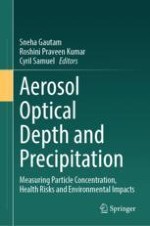Abstract
Aerosols play a significant role in the Earth’s atmospheric dynamics. Aerosol optical depth (AOD) stands out as the paramount parameter for assessing aerosol loads in the atmosphere, particularly through satellite measurements. AOD is influenced by a complex interplay of meteorological and anthropogenic factors. While these factors are inherently intertwined, the pressing need for clean air is increasingly recognized as an existential crisis.
The surge in AOD can be attributed to various drivers of economic development, including increased energy demand, urbanization, and population growth. Additionally, activities such as biomass burning, industrial emissions, and construction contribute significantly to AOD, with emissions of precursors like NO2 and SO2 playing crucial roles. The diversity of aerosol types further complicates the assessment of AOD; each type exerts its own distinct influence on atmospheric dynamics.
Moreover, the size of aerosols also plays a discernible role in their impact. The combination of aerosols and their interaction with atmospheric dynamics adds further complexity. AOD and cloud dynamics are intricately linked, and their combined effects can lead to extreme precipitation events or droughts, influenced by factors such as relative humidity and temperature.
While the implications of rising AOD vary across different landscapes, the imperative to mitigate its effects on climate and health remains paramount. Strategic planning and policies enacted by lawmakers have the potential to mitigate the anthropogenic impact of aerosols and slow down the progression of climate change. This chapter aims to provide insights into the human influence on AOD, including its sources, types, influence on precipitation, and strategies for aerosol mitigation.
